This Cooling Aloe Mint Lotion is my most popular lotion recipe for a good reason, it’s so moisturizing! It’s all thanks to a lot of aloe vera gel for hydrating combined with coconut oil for conditioning and moisturizing the skin. It’s an easy to make DIY that you can customize by changing up the essential oil to suit different seasons. This homemade lotion is easily absorbable with so much aloe vera in it, and keeps my skin nice and smooth.
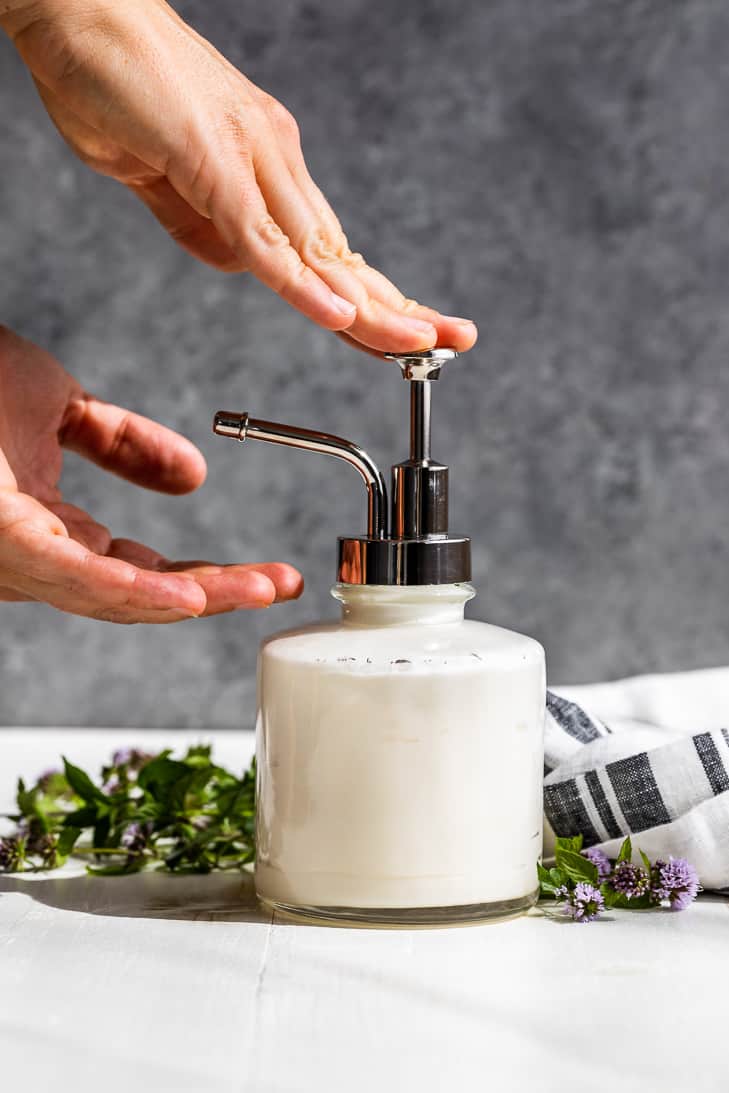
This lotion is perfect for summertime, or after excercising because of the ‘cooling effect’ from the aloe and mint. It’s particularly awesome after a long day on your feet. And I really love it massaged into my legs and feet after a day hiking in the mountains. With warmer temperatures, I like to use a light moisturizer, and the cooling effect is an added bonus.
I use straight coconut oil as a moisturizer year round. But sometimes I just need a little moisturizing, not the full coconut conditioning. The 50:50 ratio of coconut oil to aloe vera in this recipe has been the perfect amount, with just enough moisturizing. It sinks right into my skin, leaving a smooth non-greasy surface.
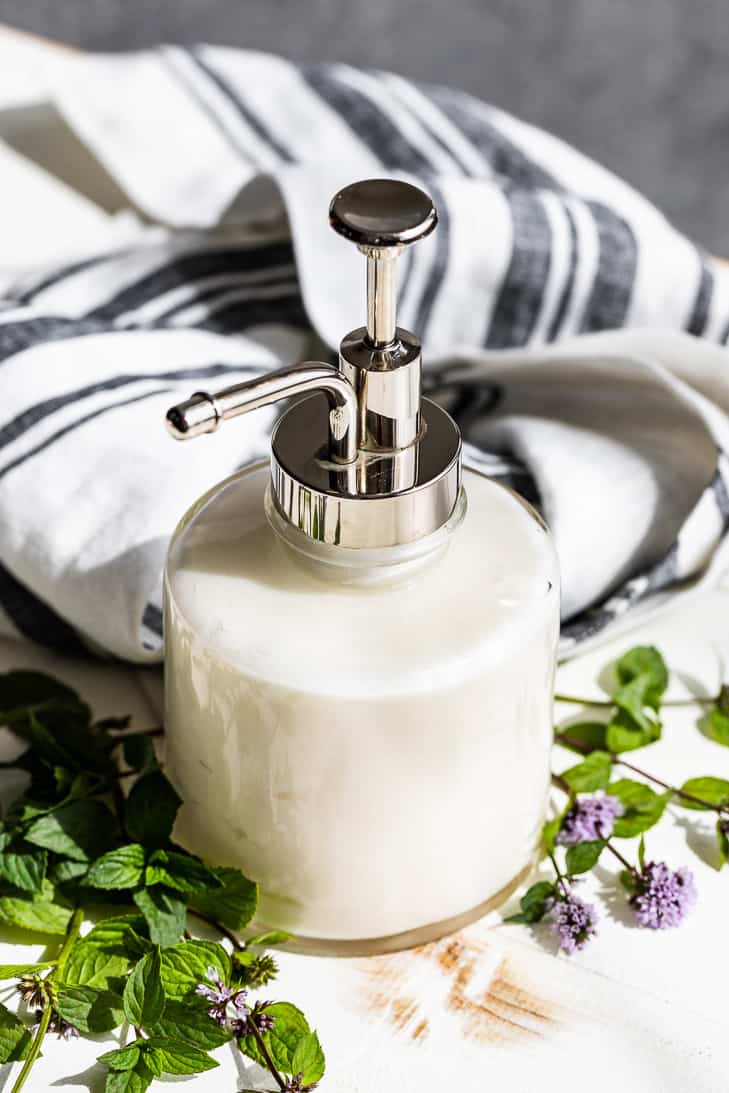
Ingredients for this Cooling Aloe Mint Lotion:
- Beeswax – I have a giant block of beeswax I’m still using up. But if you’re looking to buy beeswax I most definitely recommend getting some beeswax pellets so you don’t have to bother with grating it. However the most accurate way to use beeswax pellets is to measure by weight. So if you don’t have a scale, consider grating your beeswax instead.
- Coconut Oil – makes the perfect lightweight and easily absorbable oil to use in this lotion. And because it’s solid at room temperature it helps to thicken up the lotion as well.
- Aloe Vera Gel – I use bottled aloe vera gel, (the Desert Lily brand) because fresh aloe vera spoils too quickly to put into a lotion.
- Peppermint Essential Oil – adds to the cooling feeling of this lotion, but feel free to omit the essential oil for an unscented lotion. Or you can use any essential oil you like the smell of that works for you.
Tip: to get the beeswax off your grater, pour boiling water over the surface and watch it melt away. Or buy beeswax pellets for the easiest DIY projects!
How to make Cooling Aloe Mint Lotion:
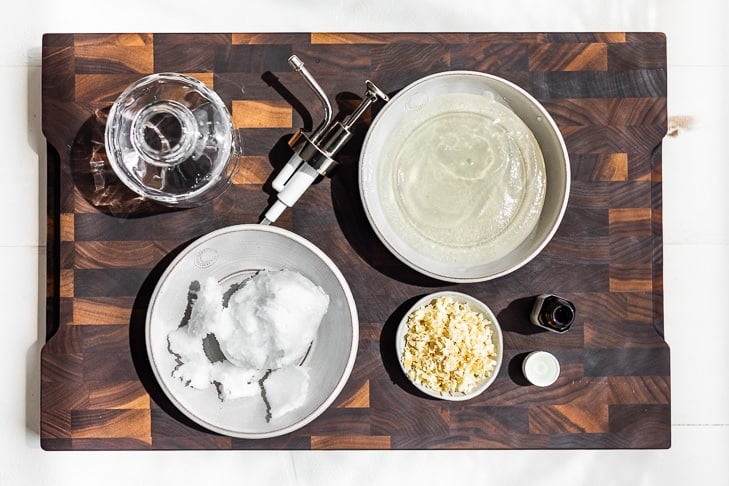
I like to have all of my ingredients ready to go before I start. That way, when the beeswax has melted into the oil, you’re ready to whisk in the aloe vera.
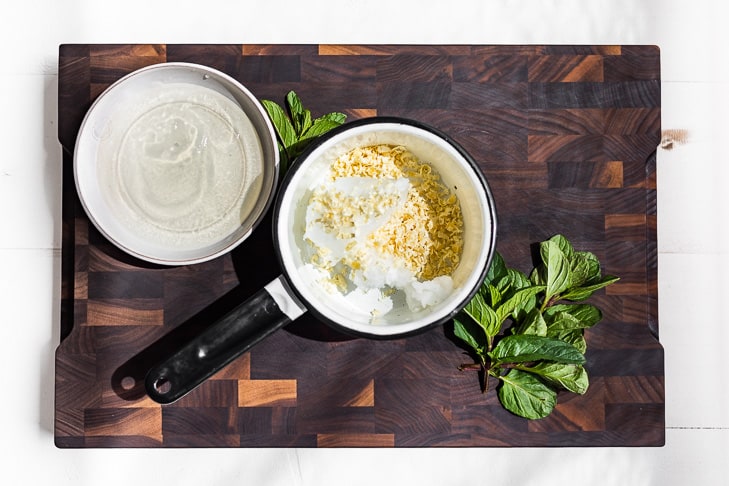
There are a couple key points to this lotion:
- It’s very important to make sure the beeswax has completely melted into the coconut oil, with no flecks remaining. If it’s not completely melted, the lotion won’t emulsify properly. And there will be little gritty pieces of beeswax in the finished product as well.
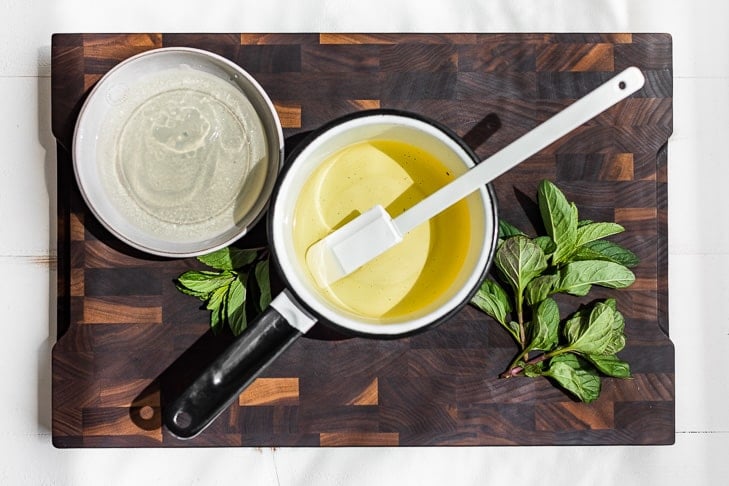
2. The aloe vera gel must be at room temperature. If you put it into the hot oil/wax mixture straight from the refrigerator, the mixture might not emulsify. Instead you might end up with clumps. Also if you add cold liquid to hot oil it can splatter. So it’s best to keep the oil mixture as cool as possible when melting the beeswax, (pictured above). Just warm it enough to melt, but don’t let it get super hot.

This mixture will look too thin at first, (above photo). But it thickens up as it cools (photo below). I like to blend mine on the lower settings of the blender to make it fluffier. Also, it sometimes separates as it cools if it hasn’t been properly emulsified.
If this happens running it for a few seconds on low in the blender has always made it stable for me. Once it’s fully cooled, I haven’t had it separate. You can also lightly warm the mixture and whisk thoroughly to emulsify if it didn’t come together the first time.
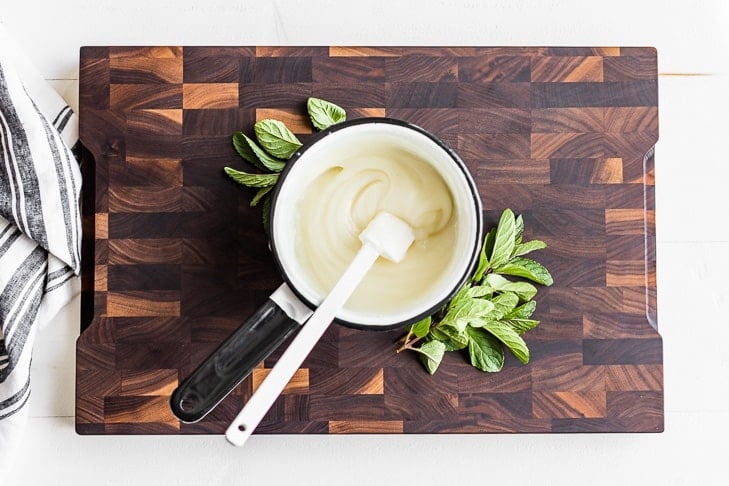
The cooling process can take 2-4 hours depending on your room temperature. It’s really best not to rush this process because by cooling down slowly the lotion becomes more stable. I’ve also put the lotion over an ice bath and stirred it vigorously until it thickens.
But if you keep it over the ice water too long, it will harden and separate, (so it really is best just to let it sit on the counter for a couple of hours). It’s not worth the hassle to speed up the cooling process all in all!
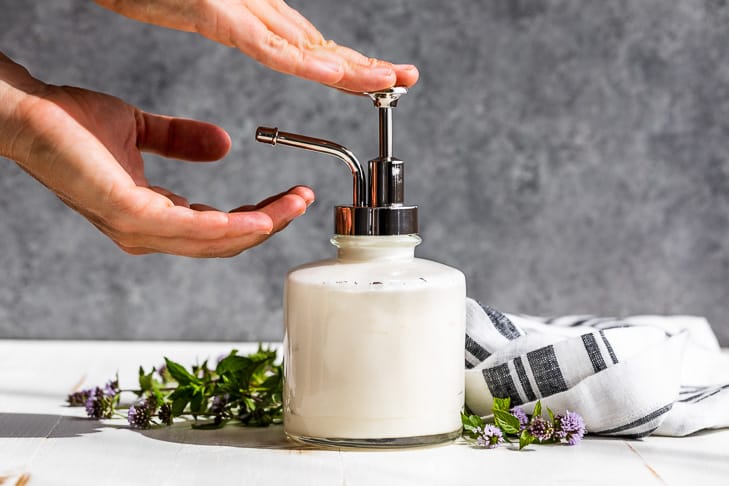
This is one of my most popular DIY recipes, and I hope all the extra tips I’ve added today will help you be successful in making your own lotion. Once you get the hang of it, it’s actually quite easy, and only takes a few minutes to whip up.
The reason this lotion needs a little extra care and attention is the large ratio of water to oil, which makes it less stable than normal lotions. This is also the reason it’s such a great summertime lotion though! If you’re looking for an easier first time project, try my Lavender Sugar Scrub, or my Easy Buttercream Lotion.
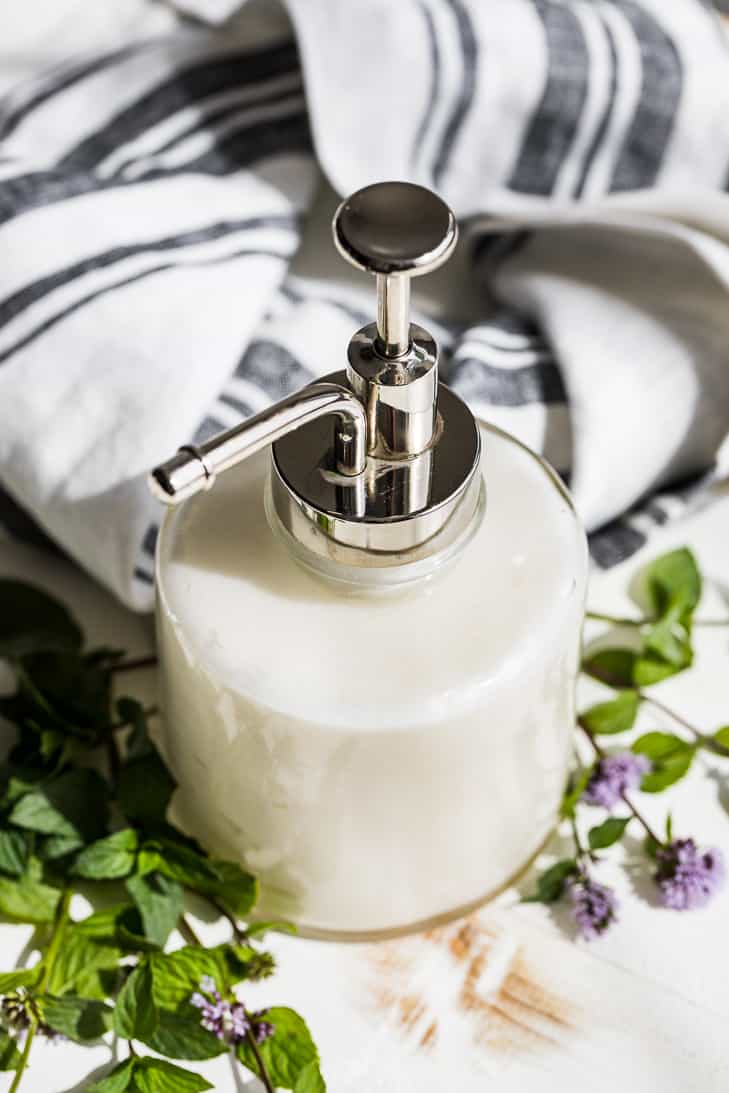
At home spa day inspiration:
- Refreshing Peppermint Sugar Scrub
- Moisturizing Mint Body Wash
- At Home Facial
- Finish with this lotion!
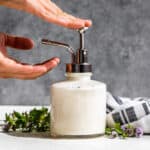
Cooling Aloe Mint Lotion
- Total Time: 15 mins
- Yield: 1 cup 1x
Description
This Cooling Aloe Mint Lotion is my most popular lotion recipe for a good reason, it’s so moisturizing! It’s all thanks to a lot of aloe vera gel for hydrating combined with coconut oil for conditioning and moisturizing the skin. It’s and easy to make DIY that you can customize by changing up the essential oil to suit different seasons. This homemade lotion is easily absorbable with so much aloe vera in it and keeps my skin nice and smooth.
Ingredients
1/4 cup grated beeswax, 11 grams
1/2 cup coconut oil, 122 grams
1/2 cup aloe vera gel, 122 grams, room temperature
1/8 Teaspoon peppermint essential oil
Instructions
Place the beeswax and coconut oil in a saucepan over low heat. Heat just until just melted with no remaining flecks of beeswax.
Try to keep the temperature as low as possible to preserve the benefits the of coconut oil.
Remove the oil mixture from the heat, and hand whisk in the room temperature aloe vera gel and peppermint essential oil until it’s thoroughly combined.
Let the lotion cool to room temperature, about 2-4 hours. Whisk again, or place in the blender and blend at a medium speed for about 30 seconds for a fluffier version.
Notes
This lotion will naturally become thicker and more solid over time, as some of the aloe vera slowly evaporates.
- Prep Time: 10 mins
- Cook Time: 5 mins
- Category: DIY
- Method: Whisking
This recipe has been updated with new photos, step by step process, and more tips and additional information in 2021.

Can I use the alo juice from my own plants? Thank you!
I’m not sure if aloe from your plants would work exactly the same because I don’t know what the consistency would be, (aloe vera gel from the store is quite thick). Also the store bought kind has a preservative in it which is why this lotion can last for weeks at room temperature. If you do want to use your own aloe, I would look into a natural preservative at your local health food store that’s made for topical cosmetics/homemade beauty products. I hope this helps, and be sure to let me know how it goes, or if you have anymore questions! 🙂
can you give me suggestion what types of igredient to do this lotion if i do not use beeswax
I know some people use liquid lecithin or stearic acid powder in place of beeswax. I don’t know what the substitution ratio would be or how the consistency would turn out since I’ve never used them myself, but those 2 are the only things I know of besides beeswax. I hope this gives you a good starting point, and I hope you enjoy the recipe!
Candelilla wax is a vegan alternative to beeswax. http://www.anarreshealth.ca/product/wax-candelilla-wax
my lotion turns out grainy. why is this happening? Also, if my aloe has preservatives in it, will this lotion last longer than a month?
If your lotion is grainy, it’s most likely because there was a problem emulsifying the wax and oil mixture with the aloe vera. If it’s just separated you can gently rewarm it, once it completely melts, remove it from the heat and stir it vigorously with a spatula over an ice bath until it comes together and is thick. If there is actual grit in your lotion, it would be because the wax didn’t get fully melted. In this case you’ll have to reheat it, (causing the aloe to loose some of it’s benefits) until it’s completely melted and clear without any flecks of wax remaining. Then follow the stirring over an ice bath procedure I mentioned before, and you should be good to go. As far as the preservatives go, I’m not sure if it will last longer, but all homemade products last the best if you never touch them with your hands. So if you put the lotion in a pump dispenser, it may last up to 2 months, but I can’t be sure with so many variables at play. Also this lotion gets thicker over time because some of the aloe vera evaporates, especially in the warmer months. I hope this answers you questions, but if not be sure to write me back with more details! 🙂
I can see you didn’t use a preservative here. How long is the shelf life of this product, and does it need to be refrigerated?
I know that it lasts well for a month without refrigeration, but I think that’s because the store bought aloe vera gel comes with it’s own preservative in it. I hope this helps, and be sure to let me know how it goes or if you have anymore questions!
Hi Kari, great recipe, thanks! I tried making this last night; I witheld a bit of coconut oil and added some shea butter as I was hoping to add some natural SPF to the cream. My aloe gel was at room temp, and after i had my oil and wax melted together I mixed in the aloe with an electric hand mixer…The aloe splattered all over and didn’t emulsify :-/ When you say whisk, am I supposed to do this by hand? Or do you think that the addition of shea butter has created the issue? I read an earlier comment where you indicated you could slowly warm the cream back up and try to re-emulsify; I’m going to give it a shot but I was wondering if you have any further tips? Thank so much!!!
Yes, it’s best to whisk by hand because an electric mixer is too powerful for such a liquid mixture. I just added note to the recipe to avoid any future problems, and I’m sorry you had a mess on your hands. You might not be able to save it depending on how much liquid you lost, but do try rewarming it and then hand whisking it. To speed things up you can stir the mixture together with a spatula over an ice bath until it thickens and becomes white and creamy – then let it cool to room temperature before hand whisking it again or blending it in a blender for a fluffier texture. I hope this helps, and be sure to let me know if you have anymore questions!
Where did you get your beeswax and did it have an overpowering odor? I’m a first time user of beeswax. I’ve been reading up on where to buy it, and I’m coming across reviews of beeswax having a strong scent, almost to the point of being unusable. Thanks for your help! I’m excited to try this recipe along with your Grapefruit Ginger body wash!
I bought my beeswax from Frontier Coop and I don’t think it has an overpowering odor, more like a light honey/waxy type scent. I haven’t bought any for a while now because they sell in bulk I still haven’t used mine up, but they’ve always been a great company. I’m including a link below if you do decide to go with them. I hope this helps, be sure to let me know how it goes, or if you have anymore questions!
http://www.frontiercoop.com/products.php?ct=hchb&cn=Beeswax
could I use water steeped with dried peppermint leaves for a water based lotion. I live in a very hot climate and all the oil based products that I have made in the past feel too greasy and sticky on the skin. Or is there any way to make this recipe lighter without the addition of water?
I’m not sure what you’re asking when you say water steeped in peppermint leaves for a water based lotion, are you asking if you can leave the oil out or the aloe vera out? I personally don’t find this lotion to be greasy or sticky as it absorbs very well into my skin, I think the trick is to find an oil that absorbs well for your skin. I know a lot of people really like jojoba oil because it is the closest in makeup to our own skin oil. I hope this helps, and be sure to let me know if you have anymore questions! 🙂
I added a 50:50 ratio of almond oil and coconut oil (I’m not too fond of the coconutty fragrance). But when I tried blending it, I didn’t get the light fluffy texture, like in your picture. Mine was a dull white and had a slightly grainy texture. What do u think went wrong? 🙁
The addition of a different oil could have easily affected both the texture and color, but as far as the graininess goes that’s usually caused when the beeswax/oil mixture doesn’t get properly emulsified with the aloe vera gel. It’s really important to have the aloe vera at room temperature before mixing it in, and it helps to stir the lotion over an ice bath at the end until it gets really thick. From there, it you’d like it fluffier, you can blend it in a blender or small food processor. Since this lotion is really high in water content, the lotion will naturally become thicker over time since there aren’t any preservatives in it. I hope this helps, but be sure to let me know if you have anymore questions.
I purchased aloe vera liquid and it was recommended to add arrowroot powder to thicken it so it would be more like a gel…I heated it in a double boiler, with the results being more like a cream gravy! How can aloe liquid become more of a gel without heating, or can aloe liquid be used in place of aloe gel?
It’s always best to use aloe gel when it’s called for because there really isn’t a way to thicken the liquid to become more like a gel. If you do use the liquid version, you could use a bit more beeswax and hopefully the final product will be similar. I hope this helps, and be sure to let me know if you have anymore questions! 🙂
Hi Kari
This is a great recipe and I can’t wait to try it as I have sensitive skin and hope the aloe vera will help where medicated creams have failed. What can I substitute for coconut oil? Coconut oil makes my skin itchy and I develop small rashes. What else can I use to get a light and non-greasy lotion?
Jojoba oil would be a great alternative in this recipe because it’s a light oil and it’s the closest in makeup to our own skin’s oil composition. You may need to add a little more beeswax if you find the lotion to be too thin because jojoba oil isn’t quite as thick as coconut oil. I would also avoid adding the mint essential oil or any essential oil if your skin is super sensitive. Let me know how it goes, and if you have anymore questions!